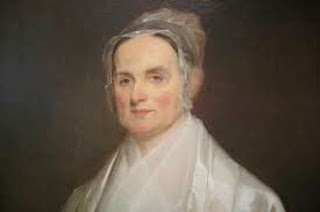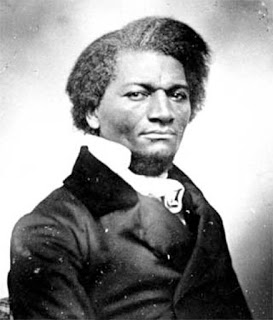Astronomy
The history of the women's rights movement in the US is interesting and I will have a couple of blogs on this topic. You my have heard of the 1848 Seneca Falls Convention which is often listed as the first significant event in the feminist movement in the US. Here is what led up to the meeting and what came to pass there.
I believe there were two key developments in the mid-1800's that led to Seneca Falls, namely the abolitionist movement and steady pressure from the Quakers. The Quakers, or Religious Society of Friends, were founded in the 1600's in England and had a fundamental belief in the dignity of all people. They were persecuted in England, but flourished in the US. Although many Quakers owned slaves through the 1700's, there were early members who spoke out against the practice. The message slowly got through and by the late 1700's most northern states had outlawed the practice. Many of the notable meetings and events in the US abolitionist movement were organized or motivated by Quakers.
By 1830, society was in an upheaval in the US. This period in American history has some similarities to the 1960's. Many people were questioning past practices and many others felt threatened by the changes. Inspired by the abolitionist movement, women of the time saw an opportunity to improve their lives. Again, the Quakers played a key role. A group of local New York Quaker women were the key organizers of the 1848 Seneca Falls Convention, along with non-Quaker Elizabeth Stanton. This was the first, or at least most notable, meeting to advance the status of women. Famous participants were Lucretia Mott, a Quaker from Philadelphia known for her speaking skills, and Frederick Douglass, the renowned African American abolitionist and orator.

Lucretia Mott
 Frederick Douglass in 1852
Frederick Douglass in 1852
Over a two-day meeting, the 300 attendees debated many issues. Some of the main ones were suffrage, property rights and social equality. A "Declaration of Sentiments" and a list of resolutions were passed and signed. These formed the basis for the demands of the women's rights movement. The meeting was covered widely in the press with both positive and negative editorials. Even the negative press contributed to the advancement of the cause by stimulating debate on the topic of fair treatment of women.
A key declaration at Seneca Falls was to have regular meetings every 1-2 years to continue the discussion of women's rights and to move the cause forward. These were interrupted by the Civil War, but then picked up again, leading to the women's suffrage push in the early 1900's. That fascinating story will be the subject of my next blog.
- Aaswomen Newsletter For July 24, 2015
AAS Committee on the Status of Women AAS Committee on the Status of Women Issue of July 24, 2015 eds: Daryl Haggard, Nicolle Zellner, Meredith Hughes, & Elysse Voyer This week's issues: 1. The Fight for Women's Suffrage 2. #StandWithChanda3....
- Aaswomen Newsletter For June 26, 2015
AAS Committee on the Status of Women AAS Committee on the Status of Women Issue of June 26, 2015 eds: Daryl Haggard, Nicolle Zellner, Meredith Hughes, & Elysse Voyer This week's issues: 1. Beginnings of the Women's Rights Movement2. Funding...
- Aaswomen Newsletter For Jun 19, 2015
AAS Committee on the Status of Women AAS Committee on the Status of Women Issue of June 19, 2015 eds: Daryl Haggard, Nicolle Zellner, Meredith Hughes, & Elysse Voyer This week's issues: 1. Inaugural Inclusive Astronomy Meeting2. Funding Diversity...
- Picture Of The Day - Nov 5
Picture Of The Day 2012 November , 5 ...
- Picture Of The Day
Picture Of The Day October 18 , Thursday : ...
Astronomy
Beginnings of the Women's Reights Movement
The history of the women's rights movement in the US is interesting and I will have a couple of blogs on this topic. You my have heard of the 1848 Seneca Falls Convention which is often listed as the first significant event in the feminist movement in the US. Here is what led up to the meeting and what came to pass there.
I believe there were two key developments in the mid-1800's that led to Seneca Falls, namely the abolitionist movement and steady pressure from the Quakers. The Quakers, or Religious Society of Friends, were founded in the 1600's in England and had a fundamental belief in the dignity of all people. They were persecuted in England, but flourished in the US. Although many Quakers owned slaves through the 1700's, there were early members who spoke out against the practice. The message slowly got through and by the late 1700's most northern states had outlawed the practice. Many of the notable meetings and events in the US abolitionist movement were organized or motivated by Quakers.
By 1830, society was in an upheaval in the US. This period in American history has some similarities to the 1960's. Many people were questioning past practices and many others felt threatened by the changes. Inspired by the abolitionist movement, women of the time saw an opportunity to improve their lives. Again, the Quakers played a key role. A group of local New York Quaker women were the key organizers of the 1848 Seneca Falls Convention, along with non-Quaker Elizabeth Stanton. This was the first, or at least most notable, meeting to advance the status of women. Famous participants were Lucretia Mott, a Quaker from Philadelphia known for her speaking skills, and Frederick Douglass, the renowned African American abolitionist and orator.

Lucretia Mott

Over a two-day meeting, the 300 attendees debated many issues. Some of the main ones were suffrage, property rights and social equality. A "Declaration of Sentiments" and a list of resolutions were passed and signed. These formed the basis for the demands of the women's rights movement. The meeting was covered widely in the press with both positive and negative editorials. Even the negative press contributed to the advancement of the cause by stimulating debate on the topic of fair treatment of women.
A key declaration at Seneca Falls was to have regular meetings every 1-2 years to continue the discussion of women's rights and to move the cause forward. These were interrupted by the Civil War, but then picked up again, leading to the women's suffrage push in the early 1900's. That fascinating story will be the subject of my next blog.
- Aaswomen Newsletter For July 24, 2015
AAS Committee on the Status of Women AAS Committee on the Status of Women Issue of July 24, 2015 eds: Daryl Haggard, Nicolle Zellner, Meredith Hughes, & Elysse Voyer This week's issues: 1. The Fight for Women's Suffrage 2. #StandWithChanda3....
- Aaswomen Newsletter For June 26, 2015
AAS Committee on the Status of Women AAS Committee on the Status of Women Issue of June 26, 2015 eds: Daryl Haggard, Nicolle Zellner, Meredith Hughes, & Elysse Voyer This week's issues: 1. Beginnings of the Women's Rights Movement2. Funding...
- Aaswomen Newsletter For Jun 19, 2015
AAS Committee on the Status of Women AAS Committee on the Status of Women Issue of June 19, 2015 eds: Daryl Haggard, Nicolle Zellner, Meredith Hughes, & Elysse Voyer This week's issues: 1. Inaugural Inclusive Astronomy Meeting2. Funding Diversity...
- Picture Of The Day - Nov 5
Picture Of The Day 2012 November , 5 ...
- Picture Of The Day
Picture Of The Day October 18 , Thursday : ...
